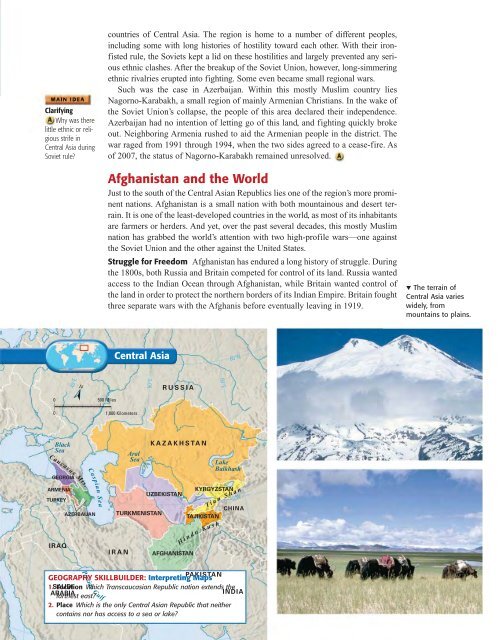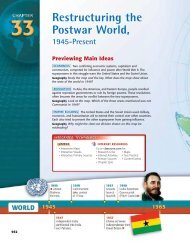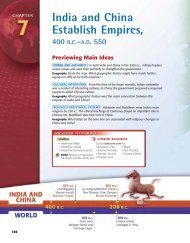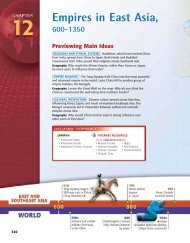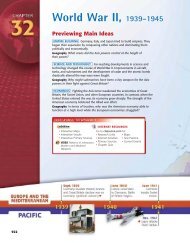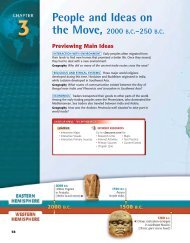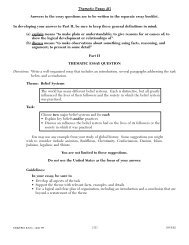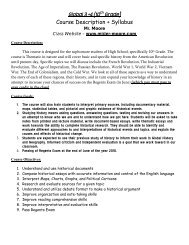Chapter 34 - First
Chapter 34 - First
Chapter 34 - First
You also want an ePaper? Increase the reach of your titles
YUMPU automatically turns print PDFs into web optimized ePapers that Google loves.
Clarifying<br />
Why was there<br />
little ethnic or religious<br />
strife in<br />
Central Asia during<br />
Soviet rule?<br />
0<br />
0<br />
Black<br />
Sea<br />
Caucasus Mts.<br />
GEORGIA<br />
ARMENIA<br />
TURKEY<br />
IRAQ<br />
40°E<br />
Caspian Sea<br />
AZERBAIJAN<br />
Persian Gulf<br />
countries of Central Asia. The region is home to a number of different peoples,<br />
including some with long histories of hostility toward each other. With their ironfisted<br />
rule, the Soviets kept a lid on these hostilities and largely prevented any serious<br />
ethnic clashes. After the breakup of the Soviet Union, however, long-simmering<br />
ethnic rivalries erupted into fighting. Some even became small regional wars.<br />
Such was the case in Azerbaijan. Within this mostly Muslim country lies<br />
Nagorno-Karabakh, a small region of mainly Armenian Christians. In the wake of<br />
the Soviet Union’s collapse, the people of this area declared their independence.<br />
Azerbaijan had no intention of letting go of this land, and fighting quickly broke<br />
out. Neighboring Armenia rushed to aid the Armenian people in the district. The<br />
war raged from 1991 through 1994, when the two sides agreed to a cease-fire. As<br />
of 2007, the status of Nagorno-Karabakh remained unresolved.<br />
Afghanistan and the World<br />
Just to the south of the Central Asian Republics lies one of the region’s more prominent<br />
nations. Afghanistan is a small nation with both mountainous and desert terrain.<br />
It is one of the least-developed countries in the world, as most of its inhabitants<br />
are farmers or herders. And yet, over the past several decades, this mostly Muslim<br />
nation has grabbed the world’s attention with two high-profile wars—one against<br />
the Soviet Union and the other against the United States.<br />
Struggle for Freedom Afghanistan has endured a long history of struggle. During<br />
the 1800s, both Russia and Britain competed for control of its land. Russia wanted<br />
access to the Indian Ocean through Afghanistan, while Britain wanted control of<br />
the land in order to protect the northern borders of its Indian Empire. Britain fought<br />
three separate wars with the Afghanis before eventually leaving in 1919.<br />
500 Miles<br />
Central Asia<br />
1,000 Kilometers<br />
TURKMENISTAN<br />
IRAN<br />
Aral<br />
Sea<br />
60°E<br />
RUSSIA<br />
KAZAKHSTAN<br />
UZBEKISTAN<br />
AFGHANISTAN<br />
KYRGYZSTAN<br />
TAJIKISTAN<br />
H i n d u K u s h<br />
Lake<br />
Balkhash<br />
T i a n S h a n<br />
CHINA<br />
PAKISTAN<br />
GEOGRAPHY SKILLBUILDER: Interpreting Maps<br />
1. SAUDI Location Which Transcaucasian Republic nation extends the<br />
ARABIA<br />
INDIA<br />
farthest east?<br />
2. Place Which is the only Central Asian Republic that neither<br />
contains nor has access to a sea or lake?<br />
80°E<br />
60°N<br />
40°N<br />
▼ The terrain of<br />
Central Asia varies<br />
widely, from<br />
mountains to plains.


